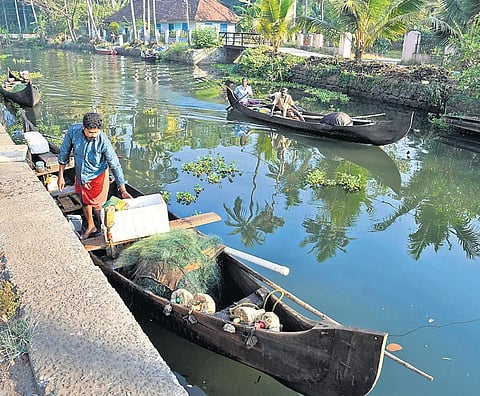

At 2pm every day, Kumarakom native Rejimon starts preparing nets for fishing in the Vembanad lake. He leaves home to go fishing on his mechanised boat at 5pm and returns only by 7am next day.
His routine hasn’t changed. He works the same number of hours. What has changed is how much he gets in return.“There were days when we got abundant catch, more than enough to manage our family. Those days are long gone. Now, we hardly catch fish worth Rs 400-Rs 600 daily. After expenses of fuel and net, there is hardly anything left,” he says.
Vembanad lake, India’s largest, is a key tourist attraction and source of livelihood for thousands of fishermen families in Kumarakom and nearby panchayats. However, the dwindling fish wealth has plunged fishermen into crisis. There are 1,400 fishermen registered with the fisheries department at Kumarakom, Thiruvarppu and Arpukara panchayats in Kottayam district. Of them, less than 50 per cent fishers go fishing now. Most have left as the money is not good.
For those still in it, the Inland Fishermen Welfare Service Cooperative Society is a big relief as it procures fish at a good price. However, president of the society K K Rajappan says inland fishermen are facing severe crisis and require government’s support. “Fish production has come down drastically. As per a study, Vembanad lake had around 172 species of fish before the Thanneermukkom regulator was constructed in 1975. Recent studies say there are only 52 species now,” he says. He blames the unscientific management of the regulator for this.
The barrage remains closed from December 15 to March 15 to prevent entry of saline water and help paddy cultivation. “The regulator was constructed to aid in paddy cultivation, but it is happening just once a year mostly in Kuttanad and Upper Kuttanad. With the regulator closed, breeding of fish has been affected. Its closure also affects the tide, which is vital for the fish population,” he says.
A fisherman for 60 years, Kunjumon says plastic waste in another headache. People are also using Kambam nets, which is an illegal practice. “The last time a cleaning drive was held, 10 truckloads of plastic waste were removed from the lake. The waste affects fish and destroys our net. Since the lake is linked with rivers in Kottayam, Alappuzha and Pathanamthitta, waste dumped there enters it. Even tourists throw plastic bottles in the water,” he says. Though tourism has had an impact on Vembanad lake, it also generated demand for fish in the local market.
“With tourism down, fish prices have also reduced. A major chunk of catch was usually purchased by hotels, resorts and homestay operators for their guests. Now, with no foreign tourists due to the pandemic, our supply depends on markets outside Kumarakom. Last year, an A Plus grade Kareemeen (pearl spot) fetched Rs 550 per kg. This year, it is in the Rs 400-Rs 450 per kg, due to low demand,” Rajappan said.
With tourism hit due to Covid-19 travel curbs, the entire economy of Kumarakom has been affected.
“Resorts and hotels were a major job provider to local residents. Now, several have lost jobs and now work as labours,” says Sathish, who runs a restaurant in Kumarakom.Jobin, who works with a resort in Kumarakom, says resorts get guests only on weekends, most of them from Ernakulam. “Almost all resorts have slashed their rents to attract tourists. But just a few come, that too on weekends . In the weekdays, resorts remain almost vacant,” he said.